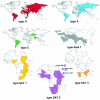Foot-and-mouth disease
- PMID: 15084510
- PMCID: PMC387408
- DOI: 10.1128/CMR.17.2.465-493.2004
Foot-and-mouth disease
Abstract
Foot-and-mouth disease (FMD) is a highly contagious disease of cloven-hoofed animals. The disease was initially described in the 16th century and was the first animal pathogen identified as a virus. Recent FMD outbreaks in developed countries and their significant economic impact have increased the concern of governments worldwide. This review describes the reemergence of FMD in developed countries that had been disease free for many years and the effect that this has had on disease control strategies. The etiologic agent, FMD virus (FMDV), a member of the Picornaviridae family, is examined in detail at the genetic, structural, and biochemical levels and in terms of its antigenic diversity. The virus replication cycle, including virus-receptor interactions as well as unique aspects of virus translation and shutoff of host macromolecular synthesis, is discussed. This information has been the basis for the development of improved protocols to rapidly identify disease outbreaks, to differentiate vaccinated from infected animals, and to begin to identify and test novel vaccine candidates. Furthermore, this knowledge, coupled with the ability to manipulate FMDV genomes at the molecular level, has provided the framework for examination of disease pathogenesis and the development of a more complete understanding of the virus and host factors involved.
Figures




References
-
- Abrams, C. C., A. M. King, and G. J. Belsham. 1995. Assembly of foot-and-mouth disease virus empty capsids synthesized by a vaccinia virus expression system. J. Gen. Virol. 76:3089-3098. - PubMed
-
- Acharya, R., E. Fry, D. Stuart, G. Fox, D. Rowlands, and F. Brown. 1989. The three-dimensional structure of foot-and-mouth disease virus at 2.9 A resolution. Nature 337:709-716. - PubMed
-
- Agol, V. I., A. V. Paul, and E. Wimmer. 1999. Paradoxes of the replication of picornaviral genomes. Virus Res. 62:129-147. - PubMed
Publication types
MeSH terms
Substances
LinkOut - more resources
Full Text Sources
Other Literature Sources

